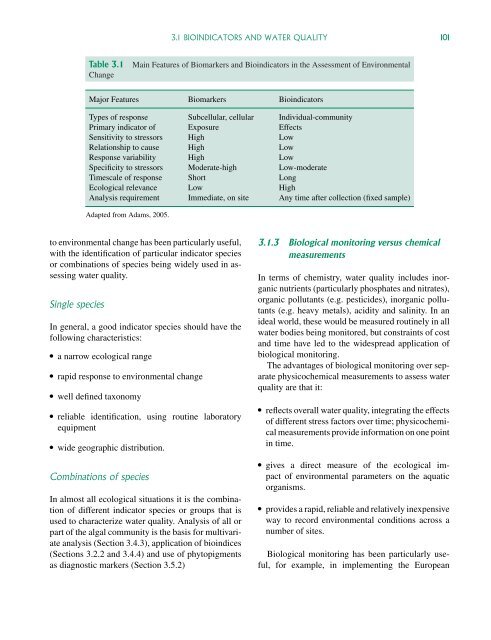Freshwater Algae: Identification and Use as Bioindicators
Freshwater Algae: Identification and Use as Bioindicators
Freshwater Algae: Identification and Use as Bioindicators
Create successful ePaper yourself
Turn your PDF publications into a flip-book with our unique Google optimized e-Paper software.
3.1 BIOINDICATORS AND WATER QUALITY 101Table 3.1ChangeMain Features of Biomarkers <strong>and</strong> <strong>Bioindicators</strong> in the Assessment of EnvironmentalMajor Features Biomarkers <strong>Bioindicators</strong>Types of response Subcellular, cellular Individual-communityPrimary indicator of Exposure EffectsSensitivity to stressors High LowRelationship to cause High LowResponse variability High LowSpecificity to stressors Moderate-high Low-moderateTimescale of response Short LongEcological relevance Low HighAnalysis requirement Immediate, on site Any time after collection (fixed sample)Adapted from Adams, 2005.to environmental change h<strong>as</strong> been particularly useful,with the identification of particular indicator speciesor combinations of species being widely used in <strong>as</strong>sessingwater quality.Single speciesIn general, a good indicator species should have thefollowing characteristics: a narrow ecological range rapid response to environmental change well defined taxonomy reliable identification, using routine laboratoryequipment wide geographic distribution.Combinations of speciesIn almost all ecological situations it is the combinationof different indicator species or groups that isused to characterize water quality. Analysis of all orpart of the algal community is the b<strong>as</strong>is for multivariateanalysis (Section 3.4.3), application of bioindices(Sections 3.2.2 <strong>and</strong> 3.4.4) <strong>and</strong> use of phytopigments<strong>as</strong> diagnostic markers (Section 3.5.2)3.1.3 Biological monitoring versus chemicalme<strong>as</strong>urementsIn terms of chemistry, water quality includes inorganicnutrients (particularly phosphates <strong>and</strong> nitrates),organic pollutants (e.g. pesticides), inorganic pollutants(e.g. heavy metals), acidity <strong>and</strong> salinity. In anideal world, these would be me<strong>as</strong>ured routinely in allwater bodies being monitored, but constraints of cost<strong>and</strong> time have led to the widespread application ofbiological monitoring.The advantages of biological monitoring over separatephysicochemical me<strong>as</strong>urements to <strong>as</strong>sess waterquality are that it: reflects overall water quality, integrating the effectsof different stress factors over time; physicochemicalme<strong>as</strong>urements provide information on one pointin time. gives a direct me<strong>as</strong>ure of the ecological impactof environmental parameters on the aquaticorganisms. provides a rapid, reliable <strong>and</strong> relatively inexpensiveway to record environmental conditions across anumber of sites.Biological monitoring h<strong>as</strong> been particularly useful,for example, in implementing the European
















